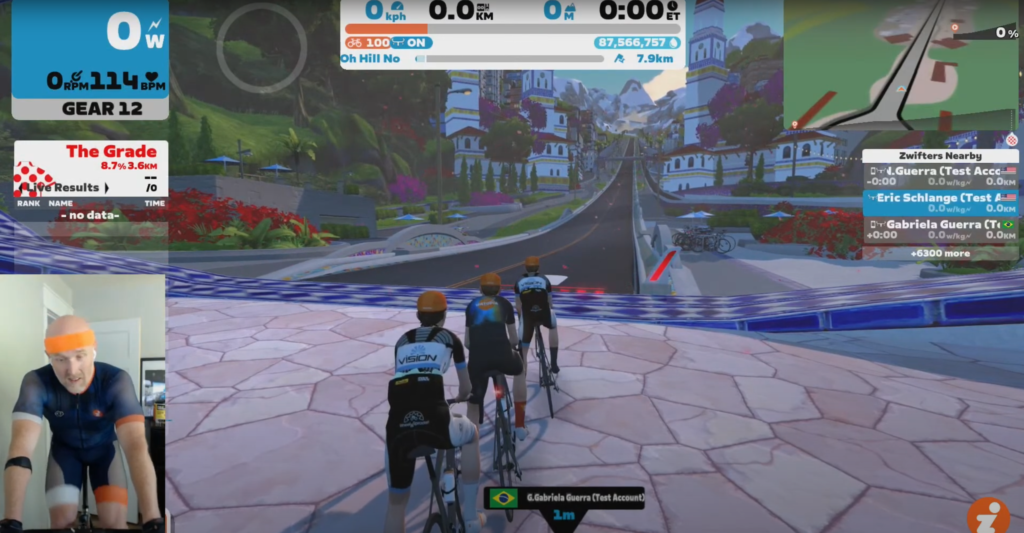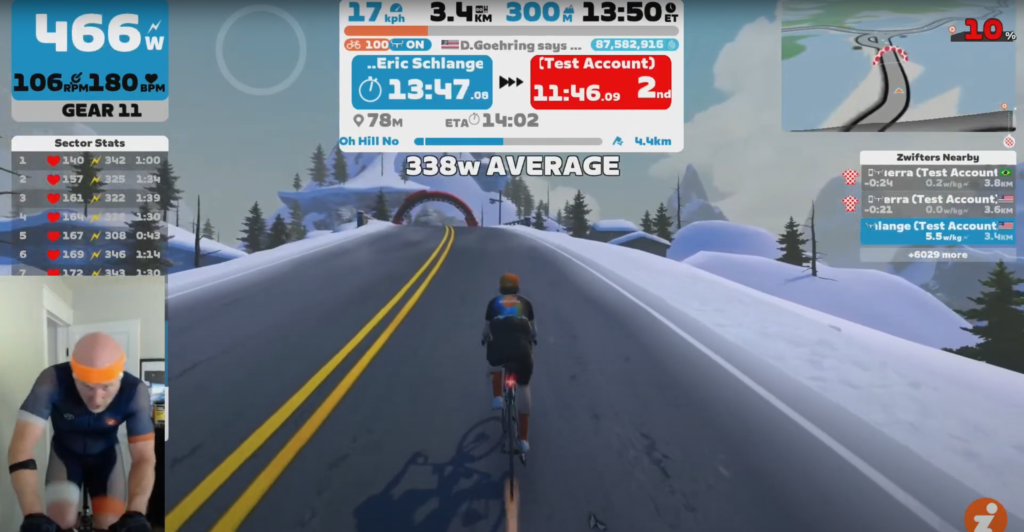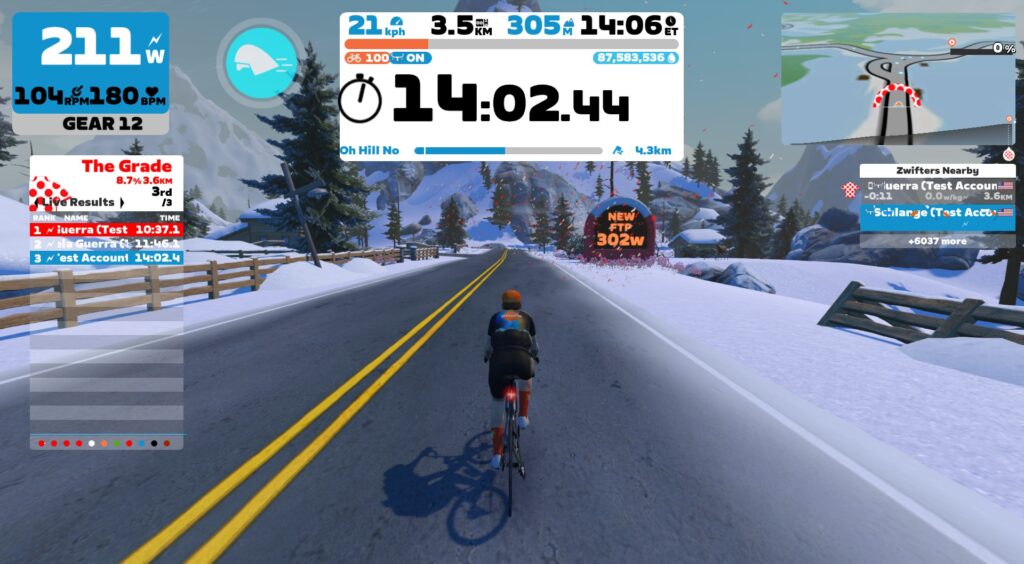If you’ve been watching Zwift news lately, you know there’s a Watopia expansion releasing this week (tomorrow, actually). We’ve talked about it repeatedly here on Zwift Insider as Zwift has revealed more and more details: first with this TSOZ post, then another teaser, then a more detailed press release.
Last week, Zwift granted access to Shane Miller (GPLama), Nathan Guerra (Zwift Community Live), and myself to ride The Grade and livestream the experience. Shane couldn’t ride it with us due to his travel schedule, but you can watch his video here. Nathan and I (along with Nathan’s wife Gabi) livestreamed our ride up The Grade one day later – see my video below:
The Grade: How It Works
The Grade is a 3.5km-long climb that is fairly steady (8.6% average), apart from short flat bits at the start, middle, and finish. It’s a KOM segment like other KOMs in Zwift, but The Grade is special in that it also functions as an FTP test!
How does that work? Well, Zwift looks at your average power and time up The Grade, then computes your FTP estimate based on those two figures. Zwift says they can do this with reasonable accuracy because they’ve analyzed the results of over 700,000 FTP tests on the platform and computed a curve which, when combined with an average power number and time value, lets them compute your FTP.
(I was going to create a sample chart here to illustrate, but I don’t want to confuse people who may think this is the actual curve from Zwift. So I’ll wait to do that until I’ve run enough tests to publish an actually accurate chart).
The curve Zwift put together would have percentage on the Y (vertical) axis, and time on the X (horizontal) axis. Time (X axis) would begin at 8 minutes (Zwift says they can’t compute accurate FTP for times shorter than that, but don’t worry, since you’d have to hold 8 W/kg to do The Grade in 8 minutes). Percentage (Y axis) would be maybe 85% at the lowest, all the way up to 100%.
This is basically a “lookup curve”, with the charted line climbing from left to right as time gets longer. If you were doing this manually you’d go to the spot on the X axis that matches the time it took you to climb The Grade, then look at the percentage value (Y axis) at that spot. Then you’d multiply your average power for the segment by that percentage to compute your FTP.
For example: it’s generally accepted that your FTP is equal to 95% of your best 20-minute power. (This is how Zwift has automatically detected FTP game-wide since the early days, in fact). So if it took you exactly 20 minutes to finish The Grade, and you averaged 200W during that time, Zwift would calculate your FTP as 200W x .95 = 190W.
Based on Nathan, Gabi, and my results, we can calculate at least three points on Zwift’s curve. But more on that below…
My Strategy
Heading into this FTP test, I wasn’t really sure where my FTP was at. I hadn’t tested it in months, hadn’t been doing any structured training, and my performance in recent races had been a bit erratic (not helped by swapping on and off various trainers/setups I’ve been testing).
My guess was that my FTP was between 300 and 310W. So, I decided to start by trying to hold 320W, then when I reached the halfway point, I would bump that up if possible.
Why this strategy? Well, because starting a bit conservatively is the best way to approach an FTP test if you’re unsure about your current FTP. But also, and perhaps more importantly, I didn’t want to blow up early and embarrass myself on a live stream!
What that plan in place, I headed out to warm up for about 30 minutes while I chatted on Discord with Nathan and Gabi and we got our livestreams set up. When the time arrived, we all picked the “Oh Hill No” route, and the fun began!
Ride Experience
The Oh Hill No route starts you just a few feet away from The Grade start line, so there’s no warmup here. (If you want to warm up first, do your warm up then pick this route and go. Or choose “Elevation Evaluation” as your route, which gives you a few km of warmup before starting The Grade.)

I hit the pedals hard to get up to speed, then tried to quickly settle into my target 320W pace.
A few minutes passed, and my legs were feeling pretty good. My average power (which is displayed on screen during the test) was holding right around 330W, but I decided not to ease up. I kept pedaling at what felt like a sustainable pace.
My power average read 328W as the road leveled out at the halfway point. I had to shift up two gears keep my power up on the short flat section, then the grade turned uphill again, and I finished sector 5. Halfway there!
I could hear Nathan doing his angry gorilla roaring, 70 seconds up the road. Gabi was 40 seconds up the road and silent. Both were putting out strong numbers in the 5 W/kg+ range, while I was barely breaking 4 W/kg. But this was no surprise, since both Nathan and Gabi are some of the best racers on Zwift!
My legs were feeling better than anticipated as I wound my way up the twisty second half of The Grade, so I increased my power to what I thought I could hold to the end. And I began doing the math in my head to estimate how much longer I had left.
I heard Nathan finish his test in 10:37, with an FTP detection of 335W. Spot on what he had guessed his FTP was currently at (4.97 W/kg based on his weight in ZwiftPower.)
A bit later Gabi finished in 11:46, with an FTP of 251W detected (4.54 W/kg based on her weight in ZwiftPower.)
(I should note here that Nathan and Gabi had done a 5-hour maximal effort ride 2 days earlier, so their legs weren’t exactly fresh for this effort.)
My average power was showing as 336W, but I was up over 370W now. Just one hairpin left! The gradient was 12%, but thanks to my 50% trainer difficulty plus virtual shifting, I had plenty of gears and was spinning at 95RPM. I stayed seated (is that still a rule for FTP tests?) and hammered my way up the final climb, spinning at 105RPM+ to keep my power high as the gradient slackened and I crossed the line:

Final FTP test results from The Grade:
- Nathan: 388W average for 10:37, 335W FTP (86.34% of average)
- Gabi: 287W average for 11:46, 251W FTP (87.45% of average)
- Me: 340W average for 14:02, 302W FTP (88.82% of average)

Concluding Thoughts
My first thought when I crossed the line and saw the 302W FTP value was, “That seems too low.” Yes, my test had only lasted for 14 minutes, but I had averaged 340W! Heading over to intervals.icu, I saw that their system estimated my FTP from the effort at 317W. That made me feel better.
As I turned around on the top and began descending The Grade, my next thoughts were that the time had passed quickly, and the test wasn’t as terrible as I thought it would be. I think the passing scenery and chasing other riders helped. Of course, knowing people were watching my effort on the livestream also helped!
Pacing oneself properly is a big part of maximizing your FTP test results, but this isn’t a straightforward proposition your first time up The Grade. I didn’t know how long it would take me to get to the top, and the 10 segments (each 357 meters long) vary somewhat in gradient, so you can’t just estimate your time based on which segment you were on.
Now that I know the layout of the climb and that I did it in 14 minutes, I think I’ll be able to pace myself better next time and bump up my FTP result by at least a few watts. I may even turn my trainer difficulty to zero so I don’t need to worry about shifting as the gradient changes.
The Best FTP Test?
Surely, The Grade’s launch is going to reopen lots of debate about FTP testing. It’s already kicking off in various chats on Reddit, Facebook, etc! Many riders are confused by how Zwift can estimate FTP using a climb segment. Others say it’s not possible to accurately detect FTP with these shorter efforts.
Here’s where I land: I think all FTP tests are just estimates, since your results are based on imperfect pacing and results calculations that are estimates themselves. 20-minute tests and that 95% figure? That’s an estimate. Ramp tests? An estimate which delivers too high of a result if you’re anaerobically-gifted. The Grade? I’m not sure, but my result felt a bit low. (Nathan said his was right on.)
In the end, the best FTP test may just be the one you’re willing to take. And I’ll be taking The Grade again, because it didn’t suck nearly as bad as the standard 20-minute FTP test!
Your Thoughts
Are you looking forward to trying out “The Grade”? What do you think of its methodology? Share your thoughts below…